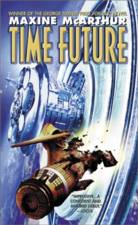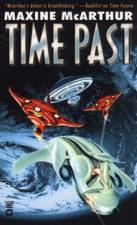

| Click on a book's image or title to order from Amazon.com |

Time Future
Warner Books/Aspect, PB, © 1999, 445 pp, ISBN #0-446-60963-3Reviewed September 2001
It's nearly impossible to read Time Future without thinking of Babylon 5. What might be most impressive about this novel is that it compares favorably to that best of all science fiction television series. Fans of the series might be able to spot some of the similarities in the synopsis:
In the early 21st century, humanity was contacted by an alien race named the Invidi. The Invidi seem to have some sort of time perception, and often speak in riddles and indirect terms. In the wake of this contact, and given favorable galactic conditions, an interspecies Confederacy was set up, including four "major" races (the Invidi; the K'Cher, who had once ruled a large span of the galaxy but have seen their empire considerably reduced; the militaristic Bendarl; and the bureaucratic Melot) and nine "minor" races who are denied much of the advanced technology of the Four (most notably, hyperdrive travel). Humanity ranks among the Nine.
Though a strange series of events, humanity ends up being given custody of a remote space station named Jocasta, which had been captured from a Confederacy enemy named the Tor. After many challenges and disasters, Jocasta was finally harnessed as a minor trading outpost, under the command of our hero and narrator, Alvarez Maria Halley. Since then, it's also become a spot for refugees to gather, straining the capacity of the station's systems. And then, several months before the book begins, a treaty among several powers in the area of Jocasta broke down when immensely powerful ships of a race called the Seouras blockaded Jocasta. With no way to contact the Confederacy, and no apparent attempts by the Confederacy to break the blockade, Halley tries to hold her station together as everything slowly falls apart.
Time Future takes place over three days, when a century-old Earth ship suddenly arrives at the station, heavily damaged. The ship had been travelling to Alpha Centauri, but no one had ever heard of it, and there was no way that its sublight drives could have brought it thousands of light-years to Jocasta, especially since its cryogenic containers were only supposed to least 50 years. Yet there are three survivors. In the wake of the ship's arrival, a K'Cher trader is brutally killed, apparently by a Q'Chn, a genetically engineered brand of K'Cher soldier which was supposedly outlawed decades earlier, and which is reputed to be invincible to all but Invidi technology. Moreover, an Invidi device was supposedly used to access the room where the body was found, but the station's Invidi representative claims to know nothing about it.
Essentially, Time Future is a mystery, with bits of science fiction horror overlaid. How did the Earth ship get to Jocasta? How did the Q'Chn get onto the station? Why was the K'Cher killed? How are the Invidi involved? Why are the Seouras blockading the station? Why isn't the Confederacy acting? McArthur does indeed manage to tie all of these elements together and almost pulls it off, although there are a few loose ends (such as how the Earth ship's unaccounted-for 50 years were spent). And, to her credit, she managed to fake me out on several plot points (I was sure I knew where the Q'Chn came from, and therefore why several other things were happening, but I ended up being wrong).
The most chilling element of the story was knowing that our heroes are doing their best, but that they lack the support of the more advanced races, and indeed are working against technologies created by those races (not to mention the mysterious Seouras, who could destroy the station on a whim), and all they have are their smarts to find a way out of the situation. The station's predicament is of course a smaller version of humanity's larger predicament in McArthur's universe, trying to fight its way out of a box that others would rather keep it inside of. (And McArthur provides some interesting throwaway lines which are quite intriguing: For instance, if all of the Nine had hyperdrive ships, then there would be that many more races able to wage interstellar war, which might not be to anyone's benefit.)
The representatives of the three species of the Four who appear, and of the one major alien species of the Nine who appears, are fairly well-drawn, although I found the K'Cher a bit too one-dimensional to really work for me. I also found Halley's ongoing battle with hunger and lack of sleep a bit too much to handle, as I'd expected her to drop into a several-day-long coma from exhaustion at any moment. At first, her ragged condition adds some extra tension to the novel, but it ceased to work for me mid-way through the story.
Time Future is most fun for its portrayal of interspecies politics and how the story grows from the essences of these relationships. There will be a sequel, it seems, which is good since there's a lot more story of the Confederacy to tell.

Time Future
Warner Books/Aspect, PB, © 2002, 479 pp, ISBN #0-446-60964-1Reviewed December 2002
We return to the world of Time Future in early 2023 - a hundred years before the events of the previous book. Alvarez Maria Halley, commander of the space station Jocasta, has been experimenting with a hyperdrive she got hold of at the end of the previous book's events, and it took her through a jump point to the year the Invidi arrived on Earth and began our trip to the stars. Unfortunately, as an undocumented unemployed person in Australia during a period of political upheaval, Halley knows what's coming but has little ability to affect it, especially since all she really wants is to contact the Invidi so they can give her a lift home.
Beyond that, Halley suspects that she's stuck in a time loop, that she's been sent back to the past for some purpose, that she's being used. The Invidi are, after all, subtle and secretive.
It's no surprise (I think) that the story doesn't take place entirely in the "past", and Jocasta is once again having troubles with the Four and those who oppose their dominance of the Confederacy. This time events focus on Jocasta's bid for neutrality from the Confederacy, and a strange hybrid Invidi ship which has turned up.
Time Past felt disappointing in the wake of Time Future. In particular, the time loop - whose ramifications consumed nearly half the book - felt not nearly as momentous as it was built up to be. While it explained what happened to the Earth ship which turned up unexpectedly in the first book, I felt it only hooked into the plot otherwise in a very loose manner. I guess the classic use of a time loop is that some element of Halley's experiences in the past would linger on and catch up with her in the future, but that doesn't happen here. There's no "aha, gotcha!" moment, which left the story feeling like there was something missing.
Time Past also felt like a "bridge" book between the first book and another story yet to come. The plot elements feel like a transition between the starting scenario and an ending one: Halley's social life evolves, the station's status is transformed, and several other changes take place, but there isn't a sense of finality, just of setup. Perhaps a third book (Time Present?) will wrap things up.
McArthur is a talented writer in her juggling of narrative and dialogue, and that's the book's best point. Although the tension is never as high as in Time Future (and some of the rescues seem too good to be true), the story moves along quickly (after the introductory 50 pages or so) and there are plenty of new developments to keep you engaged. Although we don't see as much of the aliens as I'd have liked (I mostly find them more interesting than the humans) what we do see is as much fun as it was the first time around.
Ultimately, though, I felt this book was a letdown. It didn't feel fresh, and it didn't feel momentous, which, given that it's not rich with innovative ideas, is something I think it needed. McArthur is not Lois McMaster Bujold, and future installments in the series (if any) are going to need an injection of something new and different to keep me reading.
hits since 23 September 2001.